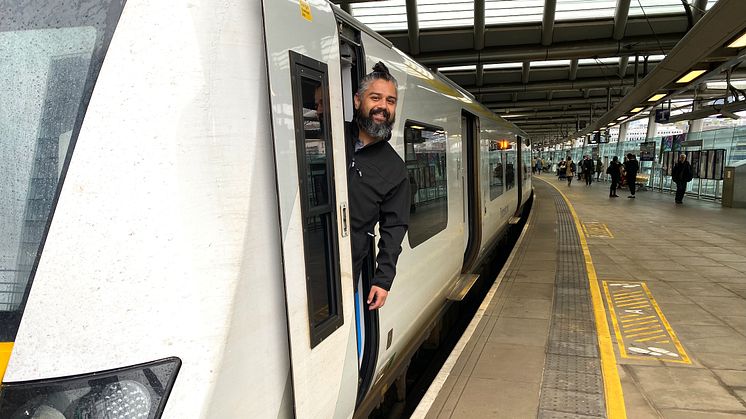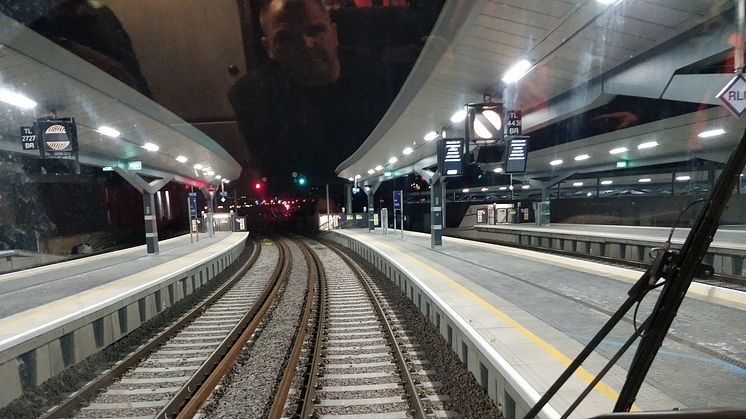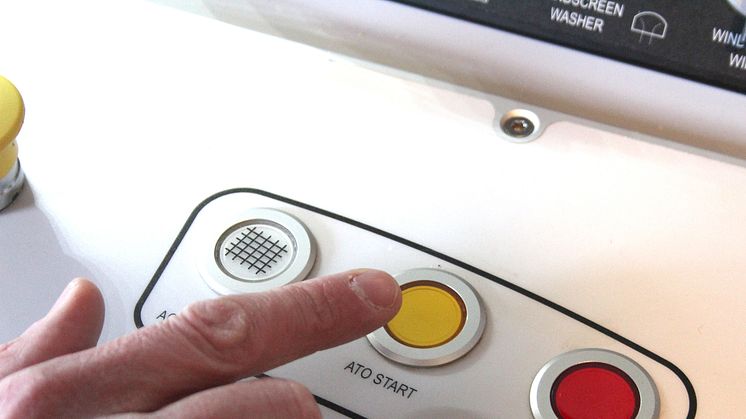
Press release -
Thameslink driver takes train on 100,000th digitally-signalled journey through heart of London, improving reliability for customers
Thameslink driver Clint Almeida made UK rail history when he took his passenger train through the heart of London using digital in-cab signalling and self-drive ‘automatic train operation’.
It was the 100,000th digitally-signalled journey and 80,000th self-drive trip between St Pancras and London Bridge made by Thameslink in a Siemens-built Desiro City train since the technology was first introduced in 2016.
Thameslink is the only mainline UK rail route to use the digital-signalling system but there are plans to roll it out further (please note, the self-drive element is not part of these roll-out plans as they are only required on this high-frequency section of the Thameslink route – see ed’s notes).
Today, just over a third of all journeys between St Pancras and London Bridge run using the digital ‘European Train Control System’ (ETCS) with extra added every week as more drivers are trained in the state-of-the-art system.
Trains travelling this way can run much closer to one another, making it easier for Thameslink to keep trains running on time and providing a more reliable service for customers as they pass through the busiest part of its massive network.
Experienced Thameslink driver Clint Almeida, 40, a father-of-three from Croydon, was in the cab of the 08:48 service from Bedford to Brighton on Friday 13 October being assessed in using the technology at the end of a five-day course delivered by Mark Webb, one of Thameslink’s in-house team of Testing and Commissioning drivers, who are experts in the system. Switching over to digital signalling on the approach to St Pancras, he then selected self-drive ATO for the journey to London Bridge. He passed with flying colours!
Clint said:“It’s much better, I can see why it’s termed ‘the railway of the future’. Digital ETCS shows me what’s up ahead up to about 2,000m away in central London and that’s safer. I know it’s going to be clear coming into the station and that helps us a lot.
“It takes a lot of getting used to, not looking at signals on the trackside and taking instructions from within the cab, but it’s good.
“Self-drive ATO takes digital ETCS to the next level and pretty much drives the train to its limit with faster acceleration and braking. We all drive differently so this makes it consistent and I’m there to manage the overall safe operation of the train.”
Drivers aren’t advised to stop and go by signals at the side of the track. Instead, they drive according to a target speed set by the system in their cab, using information relayed from beacons along the track that tells it the location of other trains. It allows drivers to ‘see’ what’s ahead up to 2km away and has added safety benefits.
All this is essential given there are trains converging on the route across London from as far afield as Peterborough, Bedford, Cambridge, Brighton, Rainham, Sutton and Sevenoaks – and any delay in the middle of the network will have a knock-on impact elsewhere.
Self-drive automatic train operation takes ETCS digital signalling one step further. Once the driver has transitioned to digital signalling, they can press a button and the system takes over, braking and accelerating automatically at optimum levels before bringing the train to a halt in the next station and opening the doors. The driver then checks the platform is clear, closes the doors and selects ATO again, and manages the overall safe operation of the train.
Grace Roche, ERTMS Thameslink Operations Manager at Govia Thameslink Railway, said:
“Reaching the 100,000thjourney in ETCS is a significant milestone and demonstrates we are moving towards digital signalling becoming our standard method of operation on this critical part of the network – and that we’re striving to deliver the most reliable service possible for our customers.
“As the biggest ETCS operation in the UK, there is a lot we can learn from our experience here. We are working closely with our colleagues at Network Rail to ensure that lessons learned are being applied to the introduction of ETCS on the Northern City Line, as part of the East Coast Digital Programme, where digitally signalled operations are expected to commence later this year.
“I’d like to thank everyone involved in getting us to this key milestone.”
Mark Merrydew, GTR’s Testing & Commissioning Driver Manager said: “My team of testing and commissioning drivers have been instrumental in helping our driver colleagues get to grips with ETCS, sharing their knowledge and experience of the system. We’ve come a long way since first introducing ETCS back in 2016 and the 100,000th digitally signalled train is a significant milestone to reach! We’re looking forward to seeing that number increase as we support more drivers to become competent in the system.”
Kevin Clark, Fleet Operations Director at Siemens Mobility, said: “It is fantastic that so many passenger journeys have been improved by this technology on our trains. The ‘core’ section of the Thameslink network is very demanding with the slightest delay having the potential to cause further delays to following trains.
“We have worked with GTR and Network Rail in fitting the ETCS signalling system which provides continuous, real-time information to the driver’s cab and allows all trains to run safely and efficiently with an optimised headway and speed profile, smoothing the flow of trains and resulting in a more reliable service for passengers.”
“We’re proud to have delivered the trains and signalling systems that have transformed rail travel for millions of Londoners.”
Ed Akers, Network Rail’s Principal Programme Sponsor for the East Coast Digital Programme (ECDP) said: “This milestone shows the experience now accumulated in the use of digital signalling. We continue to build on that knowledge as the Desiro City fleet involved is put through an upgrade to the latest version of the ETCS. That fleet, and others, will in future be making millions of digitally signalled journeys through the ECDP - Britain’s first deployment of ETCS on an intercity mainline.”
Ends
Editors’ notes
- The 08:48 Bedford to Brighton Desiro City Class 700 Thameslink train, number 700109, transitioned into ETCS Level 2 Full Supervision on its approach from Kentish Town into St Pancras on Friday 13 October.
- Today, just over a third of all journeys through between St Pancras and London Bridge in digital ETCS. Coupled with self-drive computer-driven automatic train (ATO), it provides more reliable services for customers on this important route through central London. This is set to steadily increase as more Thameslink drivers are trained in the new technology.
ETCS (digital signalling system)
- Siemens Mobility was responsible for supplying and installing the ETCS Level 2 signalling system on the Thameslink route.
- ETCS Level 2 signalling on the Thameslink route allows trains to run closer together. It overlays the existing system of lineside signals and gives Thameslink drivers continual speed information and movement authority up to 2000m ahead via a computer screen in the driver’s cab, rather than relying on fixed signals at the side of the track.
Self-drive automatic train operation (AT0)
- Approximately 80,000 (80%) of the trains that have run using the ETCS digital signalling system have also been run in self-drive automatic train operation (ATO).
- Drivers select ATO at certain specified times; driving without ATO outside these hours allows them to maintain their official competency for driving manually using the digital signalling system.
- ATO can be switched on in the driver’s cab if the train has transitioned to the ETCS digital signalling system. Under ATO, the driver must always be present. They press a button and the system takes over, braking and accelerating automatically at optimum levels before bringing the train to a halt in the next station and opening the doors. The driver then checks the platform is clear, closes the doors and selects ATO again, and manages the overall safe operation of the train.
Wider rollout of ETCS
- Last year the Government announced full funding for the East Coast Digital Programme (ECDP), which will see traditional lineside signals at the southern end of the East Coast Main Line, between Kings Cross and Peterborough, replaced with state-of the art digital signalling over the next seven years.
- Digital signalling is also being introduced on the Northern City Line between Finsbury Park and Moorgate as the first phase of the ECDP, which will see the first introduction of ETCS to an intercity mainline in Great Britain and will provide the foundation for the future expansion of digital signalling across the network.
- GTR, Network Rail and Siemens are preparing the migration to digital operations on the Northern City Line later this year. In early September, we successfully completed the final test in a series of proving runs to demonstrate that the system would be able to support the timetable – and that it is ready for GTR to start driver training in passenger service. Before we enter passenger service, the partner organisations are undertaking final readiness checks to ensure track and train will be able to work together as expected. Additionally, the partners are still awaiting final approvals from relevant bodies; the required safety case has been submitted and it’s now a case of waiting for the green light. We hope to be able to start driver training by the end of the year, once the necessary approvals are in place.
Topics
Categories
For more information, contact the press office on 0203 750 2031.
Govia Thameslink Railway
Govia Thameslink Railway (GTR) operates Thameslink, Great Northern, Southern and Gatwick Express services as follows:
- Thameslink – cross-London services between Bedford/Peterborough/Cambridge and Brighton/Horsham/East Grinstead, and between Luton/St Albans and Sutton/Wimbledon/Rainham; plus services between London and Sevenoaks
- Great Northern – services between London and Welwyn, Hertford, Peterborough, Cambridge and King’s Lynn
- Southern – services between London and the Sussex coast (Brighton, Worthing, Eastbourne, Bognor Regis, Hastings) and parts of Surrey, Kent and Hampshire (Ashford International, Southampton, Portsmouth)
- Gatwick Express – fast, non-stop direct services between Gatwick Airport and London Victoria
www.southernrailway.com, www.thameslinkrailway.com, www.gatwickexpress.com, www.greatnorthernrail.com


